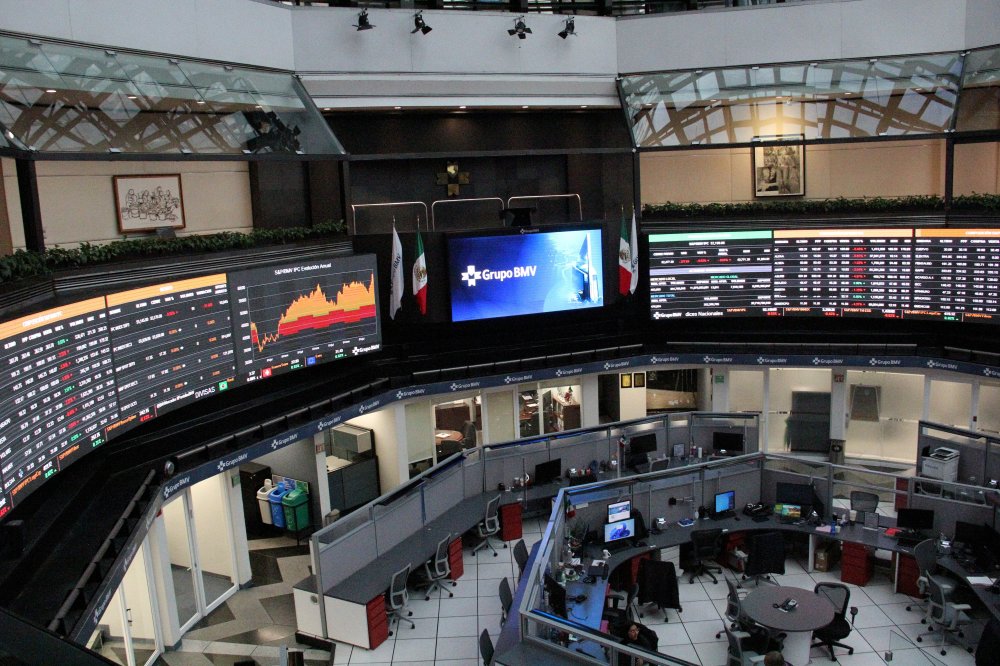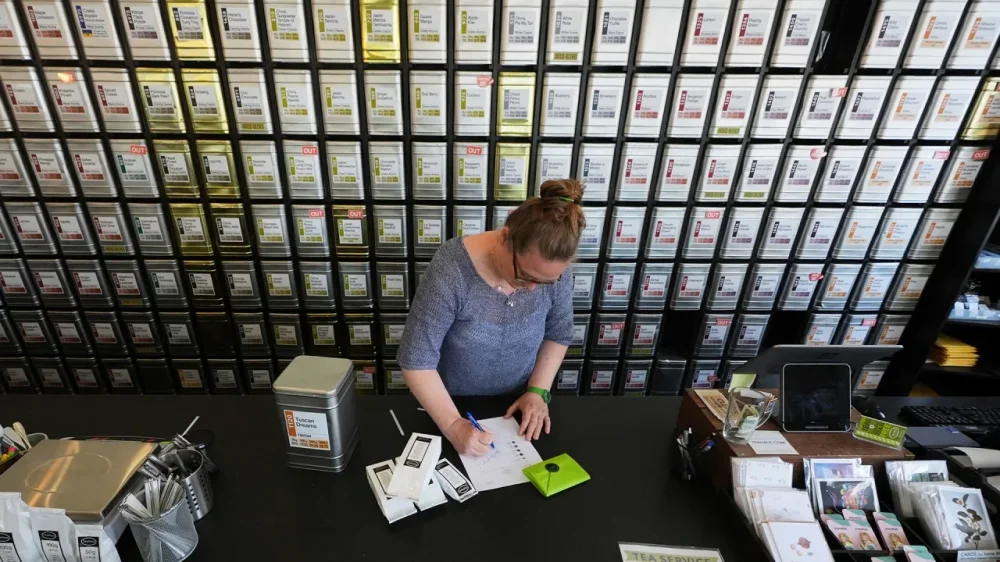All Activity
- Past hour
-
We Figured Out How AI Overviews Work [& Built A Tool To Prove It] via @sejournal, @mktbrew
Unlock the secrets of AI Overviews and realign your SEO strategy for improved visibility and relevance on Google. The post We Figured Out How AI Overviews Work [& Built A Tool To Prove It] appeared first on Search Engine Journal. View the full article
-
Home price growth stalls as market cools
While the nation's largest housing markets in New York and Chicago enjoyed greater annual home price appreciation, home values fell 1.5% in Tampa. View the full article
-
Why this economist bet big on seniors' home equity
Longbridge Financial's Christopher Mayer discusses the mortgage industry's opportunities in today's market and its shortcomings when serving older Americans. View the full article
- Today
-
In his first 100 days, Trump’s tariffs are already threatening the AI boom
When Donald The President returned to the White House in 2025, many in the tech world hoped his promises to champion artificial intelligence and cut regulation would outweigh the risks of his famously volatile trade policies. But less than 100 days into his new term, it’s clear that The President’s aggressive tariffs—and the global response to them—could pose a major threat to the AI boom that helped drive the last two years of tech innovation. AI companies are already feeling pressure on multiple fronts. They may face difficulties accessing chips and higher data center costs, and they could be hit even harder if enterprises—the main revenue source for many budding AI firms—become less willing to experiment with new AI solutions during a time of economic uncertainty. World markets tumbled on April 2 when the White House announced a 10% tariff on imports from 90 countries, plus additional “reciprocal tariffs” on 57 of them. A week later, the president paused the 10% tariffs for 90 days but kept a 145% tariff on Chinese goods in place. The President has said the China tariff would likely decrease after trade talks, but has presented little evidence that negotiations are happening at all. The tech industry, particularly hardware companies, will be significantly affected, as they’ll bear the cost of tariffs on imported components from across Asia, including China. While the The President administration reportedly exempted AI chips from tariffs, GPUs and other processors could still become more scarce and expensive. Nvidia GPUs, which power the largest AI models, are fabricated in Taiwan but incorporate components from tariffed countries such as South Korea. Additionally, many critical raw materials—rare earth metals, silicon wafers, and packaging materials originating from Taiwan and China—could be subject to tariffs as high as 30% when entering the U.S. “While tariffs aren’t causing VCs to pull back from AI investments overall, they are absolutely reshaping how investors evaluate risk,” says Samir Kumar, cofounder of the venture capital firm Touring Capital. “Investors are asking much tougher questions about supply chains—not just where companies are sourcing today, but their ability to second- and third-source critical components, and where their manufacturing is based.” That’s the supply side. But how will an unstable trade environment affect demand? Numerous sources say C-suite leaders were eager to start AI experiments during the early AI boom of 2023 and 2024. But after relatively few of those “experiments” made it into production and proved their value to the business, executives have grown far more cautious about signing new contracts with AI companies in 2025—especially with startups, says William Falcon, CEO of Lightning AI, whose cloud-based environment enables quick training and launch of AI applications. And that was before tariffs entered the picture. “So if you’re still in an experimental phase and you’ve got tariffs now, that decision kind of narrows and you’ve got to allocate those funds to something else,” Falcon tells Fast Company. “If you’ve gotten business value from AI . . . you’re more willing to invest into it, you’re more willing to carve out a bit more [budget].” On the other hand, it’s easy to forget amid the turmoil that the economy remains strong (for now), and enthusiasm around AI is still high. Kumar points out that AI has the potential to act as “a major efficiency and productivity multiplier,” which could sustain—or even boost—enterprise adoption. Thanks to these factors, many in the venture capital community had expected tech company exits to rebound in 2025, driven by AI startups getting acquired or going public. But the trade war has put those hopes on hold. No one really knows how disruptive the tariffs will be. Investors hope it’ll be a “blip” that vanishes as quickly as it arrived, allowing the AI boom to continue as scheduled. But even if the tariffs were lifted tomorrow, their effects could linger; as with the COVID-era disruptions, supply chains would likely need time to recover. On the demand side, corporations—the buyers of AI software and services—may become more conservative with their tech spending. Corporate IT budgets will increasingly reflect broader economic sentiment. Right now, things are looking gloomier: Reuters surveyed 167 economists, and 60% said the likelihood of a global recession this year was “high” or “very high.” Before his election, The President positioned himself as a champion of the AI industry, promising to shield it from unnecessary regulation. But his reckless trade policies are poised to harm the AI space more than any regulation could. Ironically, The President’s tariffs might actually create more demand for AI and robotics in the long term. The President believes his tariffs will make it so expensive to manufacture or assemble products overseas that companies will bring factories back to the U.S. But those reshored factories may not offer the kinds of jobs The President promised his base. “We should also expect tariffs to accelerate AI and robotics adoption, as companies look for ways to manage costs when reshoring or expanding into higher labor cost markets,” Kumar says. View the full article
-
Why the US will lose against China
The President’s unreliable America is throwing away the assets it needsView the full article
-
New Grant Program Launched to Boost Northeast Dairy Workforce Development
The Northeast Dairy Business Innovation Center (NE-DBIC) has announced the launch of the Catalyzing Regional Dairy Workforce Grant program, aimed at expanding workforce development programming across the Northeast dairy sector. Applications for this grant opportunity will be open from April 24 through June 5, 2025. The program offers funding to support the development, expansion, and operation of existing dairy workforce programs. Eligible projects may include federally registered apprenticeships, state registered apprenticeships, pre-apprenticeships, internships, or other workforce training initiatives. According to NE-DBIC, funded projects must focus on enhancing program operations, expanding services, and providing participant support. The initiative seeks to address one or more key areas: expansion of current programming, addition of new programs, or support for participant costs. Expansion efforts may include increasing the number of participants, broadening geographic reach, offering new certifications, or fulfilling requirements to achieve federal Registered Apprenticeship status. Programs may also add new initiatives to create additional participation pathways for underserved audiences. Participant support efforts aim to offset trainee costs to drive higher participation and stronger engagement from both trainees and businesses. Additional activities such as program marketing, educational platform development, multi-state or multi-business collaboration, and engagement with subject matter experts that directly support the project may be included. Grants will range from $20,000 to $100,000, with a total of up to $800,000 available. No matching funds are required for this program. NE-DBIC emphasized that this grant program is not scheduled to be offered again. Eligibility for the Catalyzing Regional Dairy Workforce Grant is open to applicants across the Northeast region, including Connecticut, Delaware, Maine, Maryland, Massachusetts, New Hampshire, New Jersey, New York, Pennsylvania, Rhode Island, and Vermont. Applicants based outside the region may apply if they currently provide services within the Northeast. Eligible applicants must be organizations or businesses that currently provide dairy workforce programming or serve Northeast participants. These include universities, colleges, technical career centers, manufacturing training centers, registered apprenticeships, internships, non-profit entities, and producer or trade associations that promote dairy products originating from the Northeast. However, associations receiving more than 50% of their funding from producer check-off dollars are not eligible. Licensed dairy processors that transform raw milk, dairy components, or dairy mix into edible products for human consumption are also eligible if they are licensed to sell products across state lines and source or produce milk within the Northeast. Farm-based workforce programs qualify if offered through eligible applicant categories. The grant is not intended to support individual dairy businesses. Interested applicants must register in WebGrants, a process that can take up to two business days, and are encouraged to review the full Request for Applications (RFA) and available applicant resources. Applications must be submitted through WebGrants by 2 p.m. on June 5, 2025. Applicants are also advised to secure a Unique Entity Identifier (UEI) through SAM.gov during the application period to facilitate a timely start to their grant, if awarded. For questions, applicants can contact Laura Ginsburg at Laura.Ginsburg@vermont.gov. Image: Canva This article, "New Grant Program Launched to Boost Northeast Dairy Workforce Development" was first published on Small Business Trends View the full article
-
New Grant Program Launched to Boost Northeast Dairy Workforce Development
The Northeast Dairy Business Innovation Center (NE-DBIC) has announced the launch of the Catalyzing Regional Dairy Workforce Grant program, aimed at expanding workforce development programming across the Northeast dairy sector. Applications for this grant opportunity will be open from April 24 through June 5, 2025. The program offers funding to support the development, expansion, and operation of existing dairy workforce programs. Eligible projects may include federally registered apprenticeships, state registered apprenticeships, pre-apprenticeships, internships, or other workforce training initiatives. According to NE-DBIC, funded projects must focus on enhancing program operations, expanding services, and providing participant support. The initiative seeks to address one or more key areas: expansion of current programming, addition of new programs, or support for participant costs. Expansion efforts may include increasing the number of participants, broadening geographic reach, offering new certifications, or fulfilling requirements to achieve federal Registered Apprenticeship status. Programs may also add new initiatives to create additional participation pathways for underserved audiences. Participant support efforts aim to offset trainee costs to drive higher participation and stronger engagement from both trainees and businesses. Additional activities such as program marketing, educational platform development, multi-state or multi-business collaboration, and engagement with subject matter experts that directly support the project may be included. Grants will range from $20,000 to $100,000, with a total of up to $800,000 available. No matching funds are required for this program. NE-DBIC emphasized that this grant program is not scheduled to be offered again. Eligibility for the Catalyzing Regional Dairy Workforce Grant is open to applicants across the Northeast region, including Connecticut, Delaware, Maine, Maryland, Massachusetts, New Hampshire, New Jersey, New York, Pennsylvania, Rhode Island, and Vermont. Applicants based outside the region may apply if they currently provide services within the Northeast. Eligible applicants must be organizations or businesses that currently provide dairy workforce programming or serve Northeast participants. These include universities, colleges, technical career centers, manufacturing training centers, registered apprenticeships, internships, non-profit entities, and producer or trade associations that promote dairy products originating from the Northeast. However, associations receiving more than 50% of their funding from producer check-off dollars are not eligible. Licensed dairy processors that transform raw milk, dairy components, or dairy mix into edible products for human consumption are also eligible if they are licensed to sell products across state lines and source or produce milk within the Northeast. Farm-based workforce programs qualify if offered through eligible applicant categories. The grant is not intended to support individual dairy businesses. Interested applicants must register in WebGrants, a process that can take up to two business days, and are encouraged to review the full Request for Applications (RFA) and available applicant resources. Applications must be submitted through WebGrants by 2 p.m. on June 5, 2025. Applicants are also advised to secure a Unique Entity Identifier (UEI) through SAM.gov during the application period to facilitate a timely start to their grant, if awarded. For questions, applicants can contact Laura Ginsburg at Laura.Ginsburg@vermont.gov. Image: Canva This article, "New Grant Program Launched to Boost Northeast Dairy Workforce Development" was first published on Small Business Trends View the full article
-
Why design—not technology—is key to solving our environmental crisis
As global temperatures rise and there’s a seemingly endless series of climate disasters, it’s natural to look to technology as a solution. From carbon capture (where emissions aren’t released into the atmosphere but buried in the ground) to geo-engineering (where particles are sprayed into the atmosphere to reflect sunlight and lower temperatures), green innovations are frequently touted as the way to resolve our continued reliance on fossil fuels. But in our eagerness for silver bullets, we may be susceptible to optimism bias, focusing too much on potential benefits while ignoring many of the negative effects or drawbacks. A 2022 essay in Nature argues that many of these technologies are often overhyped and don’t include the significant associated challenges, costs, and unintended consequences. For instance, discussions of EVs and their required batteries usually don’t address the harmful extraction of necessary minerals like silicon, lithium, and cobalt. A less flashy type of climate innovation that can have real impact now doesn’t hype technical fixes and instead focuses on rethinking a company’s operations, including its use of materials and redesign of supply chains. Sustainability must start with product design Studies have shown that 70%–80% of a product’s environmental impact is determined during the design phase, something I’ve also heard from many of the companies I’ve researched over the last two decades. For instance, Riccardo Bellini, former CEO of luxury fashion house Chloé, told me that an analysis of the company’s full environmental footprint in 2020 revealed that 80% of the company’s sustainability challenges could be “solved at the design table”—specifically that 58% of Chloé’s emissions stemmed from raw materials like cotton, leather, and virgin cashmere. Understanding this led the company to prioritize lower-impact materials like linen and hemp in new collections, and increase its use of recycled materials, particularly cashmere. And for leather products, Chloé began sourcing through a supplier that had third party certifications ensuring that their tanning and manufacturing processes followed strict environmental standards. But Chloé has remained cautious about vegan leathers, because while it’s an area of tech-focused innovation, many leather substitutes are derived from fossil fuel-intensive sources. Bellini told me the company committed that by 2025, 90% of its fabrics would be “lower impact,” a goal it’s on track to meet, as 85% of its products were made with these materials in 2024. Many of the companies I have researched and written about, from injection molding company Cascade Engineering to waste-management platform Rubicon, have similarly shown that initiatives focused on rethinking inputs and supply chains result not only in positive environmental effects but also significant monetary savings. Going beyond “do less harm” Seventh Generation’s former CEO Joey Bergstein also emphasized to me that another reason why sustainability must start with product redesign is that it can allow companies to avoid some emissions in the first place. This approach contrasts with corporate environmental work that begins after the product is produced, so at most can only focus on doing less harm. Thus, at Seventh Generation, the company’s research and development team aims to rethink products from the ground up, for example exploring new formats or delivery methods that can avoid the use of plastic, a material that’s made from fossil fuels and is hard to recycle. A key initiative at the company is reducing water usage in its products, which has important carbon emissions benefits as it cuts shipping weight and the need for plastic packaging. For instance, Bergstein told me Seventh Generation has active research efforts to create effective waterless products—such as in powder or tablet forms that are packaged in easily recycled materials like cardboard or steel—for laundry, dish cleaning, counter cleaning, and handwashing. In 2020, one example of this work moved from the lab to the market when the company introduced a line of cleaning products packaged in steel canisters that avoid using plastic altogether. Seventh Generation is not alone in this approach of prioritizing avoidance of plastic in product development. Leaders at Grove Collaborative told me how they reformulated shampoo products to be a bar (so could be packaged in cardboard) as opposed to a liqud, and footwear and apparel company Allbirds created a new material for shoe soles made from natural sources. Toward a more holistic view of sustainability What these examples show is that while it is easy to fall under the spell of sexy green innovations, our sustainability challenges in fact require hard work beyond superficial tweaks or isolated innovations. Instead of merely striving to “do less harm,” to the environment, which results in incremental changes, companies must take holistic views of their products—starting with design. They must recognize that true impact lies not just in isolated efficiencies or technological innovations but in reimagining supply chains, production, and business models to contribute positively to the planet and society. View the full article
-
Clients Need You for Growth
Two experts chime in. By Martin Bissett Passport to Partnership Go PRO for members-only access to more Martin Bissett. View the full article
-
Clients Need You for Growth
Two experts chime in. By Martin Bissett Passport to Partnership Go PRO for members-only access to more Martin Bissett. View the full article
-
10 Must-Have Workflow Management Software Features
Clunky workflows slowing you down? Workflow software can help smooth them out and get your projects back on track. Look for these 10 key features to boost productivity, automate tasks, and keep your projects moving. The post 10 Must-Have Workflow Management Software Features appeared first on The Digital Project Manager. View the full article
-
My Favorite Amazon Deal of the Day: The Apple AirPods 4
We may earn a commission from links on this page. Deal pricing and availability subject to change after time of publication. Prior to September 2024, any Apple user interested in active noise-canceling (ANC) AirPods would've had to shell out $250 for the AirPods Pro. With the release of the ANC AirPods 4, the tech is much more affordable—and you can currently grab a pair of these $179 earbuds for $148.99. Meanwhile, Amazon is also selling Apple's more budget-friendly version of the AirPods 4 without ANC for $99.99, down from $129. Both of these prices mark record lows, according to price-tracking tools. While the discounts aren't mind-blowing, the fact we're seeing any price reductions on the latest AirPods makes them a good deal, relatively speaking—especially outside of the typical Prime Day/Black Friday sales window. Wireless Earbuds, Bluetooth Headphones, Personalized Spatial Audio, Sweat and Water Resistant, USB-C Apple AirPods 4 (Without ANC) $99.99 at Amazon /images/amazon-prime.svg $129.00 Save $29.01 Get Deal Get Deal $99.99 at Amazon /images/amazon-prime.svg $129.00 Save $29.01 Wireless Earbuds, Bluetooth Headphones, with Active Noise Cancellation, Adaptive Audio, Transparency Apple AirPods 4 (With ANC) $148.99 at Amazon /images/amazon-prime.svg $179.00 Save $30.01 Get Deal Get Deal $148.99 at Amazon /images/amazon-prime.svg $179.00 Save $30.01 SEE -1 MORE The AirPods 4 have updated USB-C charging. Both models are powered by Apple's H2 chip, so you'll get Personalized Spatial Audio (so you can hear sounds seemingly coming from different directions as you move your head) and the ability to use head gestures to tell Siri "yes" or "no" (this also works for answering or denying calls). It's also likely Apple will add a live translation feature to both models when iOS 19 rolls out later this year. If you spring for the ANC AirPods 4, you'll get a charging case with a built-in speaker, which you can use with Find My to locate it if you lose them. You'll also get features like Conversation Awareness, which lowers your music volume when your AirPods detect that you're talking to someone; Transparency Mode, which lets you better hear your surroundings while your earbuds are in; and Adaptive Audio (combines ANC and Transparency mode to adjust ANC levels based on the noise around you). Keep in mind that since these are open-style earbuds, lacking a silicone tip to better block out noise, the ANC will not be as good as what you can get from AirPods Pro or Beats Fit Pro. Both versions are rated IP54 for dust and water resistance, offer up to five hours of listening per charge (up to 30 hours with the charging case), and can handle automatic switching with your other Apple devices. You can read more about the non-ANC AirPods in PCMag's "excellent" review, and more about the ANC AirPods in PCMag's "outstanding" review. View the full article
-
White House lashes out at ‘hostile and political act by Amazon’
Spat comes after report alleged the tech giant was planning to display price increases caused by The President’s tariffsView the full article
-
Two and Roundpoint eye opportunities for diversification
The REIT and its home finance unit are seeking expanded opportunities in servicing and originations as market unpredictability has a mixed impact on its investments. View the full article
-
3 tips to balance your short-term and long-term savings goals
You shouldn’t have to cross your fingers and hope for a strong stock market to coincide with your short-term goals. And right now, you probably wouldn’t want to. Because you’re working within a short time frame—think two to six years—investing for shorter-term goals like buying a house or paying for a wedding should look different from the portfolio you build for retirement. But don’t stop putting away money for your long-term goals while you’re working toward your short-term ones. So, how do you balance saving for both? How to think about funding short-term and long-term goals Don’t forgo saving for the long term to meet your short-term goals. Thanks to the power of compounding over time, saving early can have a large impact on your long-term outcomes. The longer the time frame, the greater the potential impact. You should put retirement front and center, especially as you approach your midcareer. Earlier in your career, you might shift your savings somewhat to shorter-term goals, but retirement should still be part of the equation. At least, take advantage of any retirement match that your employer might offer. To some extent, what you’re saving for can tip the balance as well. You might direct more of your savings away from retirement if you’re saving for a house than if you’re saving for a vacation. Account types that work for short-term investing It’s helpful to separate your short-term portfolio from your retirement portfolio, but there are some accounts that you can use to multitask. Depending on your situation, you might use a tax-deferred account, like a Roth IRA, or a taxable brokerage account. Traditional IRAs are less appealing for short-term investing because there are tax penalties when you withdraw from the account before age 59 and a half. Unlike traditional IRAs, Roth IRA contributions can be withdrawn at any time and for any reason without taxes or penalties. That makes a Roth IRA a perfect “multitasking” account for younger investors who need to build up both an emergency fund and retirement assets. Roth IRAs also allow you to withdraw up to $10,000 of earnings (in addition to any contributions) to help pay for a down payment on a first home if the account has been open for at least five years. Finding the right investments to meet near-term goals Unlike a long-term portfolio, which has a timeline of 10-plus years, the main goal of a short-term portfolio should be to outpace inflation while protecting what you’ve saved. Maximizing portfolio growth is less of a priority because the added risk likely isn’t worth the reward. Being able to buy a home in three years feels very different from affording it in seven because your investments lost value in the interim. Common mistakes that investors make are either in taking on too much risk or not enough. Some investors might assume that because stocks have beaten other asset classes over long time periods, they’re also a good choice for the short term—but they aren’t. Other investors might stick with guaranteed products, like CDs or money market accounts, because they’re concerned about protecting their savings. This approach leaves them at a disadvantage because inflation will eat into the value of those savings. Holding cash-type investments is a good idea if your timeline is super short—less than two years. Short-term investment portfolio examples Explore model portfolios that show what reasonable short-term portfolios look like. The portfolios consist of cash and shorter-term bonds. You might include a dash of stocks for growth potential, but the bulk of your money for short-term goals should be in safer, lower-returning assets. This article was provided to The Associated Press by Morningstar. For more personal finance content, go to https://www.morningstar.com/personal-finance Margaret Giles is a senior editor of content development at Morningstar. —Margaret Giles, Morningstar View the full article
-
Hims & Hers stock price soars after partnership with Novo Nordisk to offer weight-loss drug Wegovy
Shares in Hims & Hers Health, Inc. (NYSE: HIMS) are skyrocketing in early-morning trading today after the telehealth company announced a new partnership with the Danish pharmaceutical giant Novo Nordisk. That partnership will see Hims & Hers offer Novo Nordisk’s weight-loss drug Wegovy through its platform. Here’s what you need to know. Hims & Hers will offer weight-loss drug Wegovy Hims & Hers Health announced today that it has entered into “a long-term collaboration” with Danish drugmaker Novo Nordisk to offer its popular weight-loss drug Wegovy to its users through the Hims & Hers platform. The news sent HIMS shares soaring in early-morning trading. Novo Nordisk is the maker of the Wegovy weight-loss drug. The popular GLP-1 drug is often prescribed for those who wish to manage their obesity and lose weight. In recent years, people who have struggled to lose weight via traditional diet and exercise regimens have increasingly turned to GLP-1 medications. The collaboration between Hims & Hers and Novo Nordisk will see the telehealth company’s platform integrated with Novo Nordisk’s NovoCare Pharmacy, allowing Hims & Hers users to acquire “all dose strengths” of the Wegovy weight loss drug. The aim of the partnership is to blend Hims & Hers’s holistic telehealth offering with proven weight-loss medication and to offer the drug to self-paying patients. Hims & Hers says that the medication, along with a required Hims & Hers membership, will be offered to users for $599 per month. It will begin offering the drug this week. HIMS stock surges Shortly after Hims & Hers announced the Novo Nordisk Wegovy collaboration, HIMS stock surged in premarket trading this morning. As of the time of this writing, in early-morning trading, HIMS stock is currently up over 26% to over $36 per share. The stock surge suggests that investors see the Novo Nordisk collaboration as a potential major accelerator for Hims & Hers memberships that could lead to increased recurring monthly revenue. However, at around $36 per share, Hims & Hers stock price is still well below its all-time high of nearly $73 per share in February. That month, the company released its Q4 results and announced that it would stop offering compounded semaglutide, the active ingredient used in Wegovy and similar GLP-1 weight loss drugs, CNBC noted. In May 2024, Hims & Hers stock surged after it had been allowed to offer a compounded semaglutide due to a semaglutide shortage. But once the U.S. Food and Drug Administration (FDA) declared that the shortage had resolved, Hims & Hers could no longer offer the compounded drug. HIMS stock sank 22% after that announcement in February, reported CNBC at the time. It’s understandable, then, why HIMS shares are surging so much in trading today after the company announced once again that it would be able to offer a GLP-1 weight loss drug—and not just a compounded version, but the brand-name version, Wegovy. With today’s stock surge, HIMS shares are now up nearly 48% year-to-date. Over the past year, HIMS shares have now surged nearly 185%. View the full article
-
Claude Sonnet 3.7 is the leading LLM for AI SEO: Report
Claude Sonnet 3.7 is the top-performing large language model (LLM) – it outperforms competitors like Google’s Gemini, Meta’s Llama, and X’s Grok. That’s according to SEO agency Previsible’s new AI SEO Benchmark report. By the numbers. Claude Sonnet 3.7 “performed the best across the board,” earning an 83% score. But that score fell short against human SEOs (who scored 89%). LLMs averaged: 85% on content tasks. 79% on technical SEO. 63% on ecommerce SEO. Here’s how the other language models scored: Perplexity: 82% Gemini 2.5: 81% ChatGPT 4o: 79% ChatGPT o3-mini: 78% Copilot: 78% Deepseek: 78% Gemini 2.0 Flash: 71% Llama 4: 71% Grok 3: 71% Why we care. AI is getting better at handling various routine SEO tasks (e.g., content generation, keyword mapping). However, the real value in SEO comes from human expertise: strategic planning, technical execution, cross-discipline collaboration, and creative problem-solving. Relying too heavily on LLMs could expose brands to costly SEO mistakes and search visibility. Persona helps. One interesting finding was that adding a persona to a prompt (e.g., “you are an SEO expert”) improves performance by 2.8%, on average. What doesn’t help. Allowing LLMs to use web search resulted in 3.2% worse performance on average. Also, deep research resulted in 5.7% worse performance, on average. About the data. Previsible created a 50-question SEO test set covering key categories like content, technical SEO, and ecommerce. Each question had objectively correct answers based on established best practices and was independently scored by multiple SEO experts to ensure consistency. The benchmark measures accuracy – so an 83% score means a model answered 83% of questions correctly. All models were tested across different modes (e.g., with and without SEO personas, web search access) to evaluate how various features impacted performance. Between the lines. The core flaw of using LLMs for SEO? AI is probabilistic – it predicts, it doesn’t know. “Until [models] are 99%+ reliable, it’s impossible to rely too heavily on them. Your best bet is using them for what they’re good at – like building content briefs or identifying internal link opportunities using embeddings,” according to David Bell, Previsible SEO co-founder. What’s next. Previsible plans to update its AI SEO Benchmark here. The report. Leaderboard Launch: Previsible’s New AI SEO Benchmark View the full article
-
Google disables Discover performance report hack to get desktop data
Earlier this month, we reported that Google will be bringing Discover to the desktop version of Google’s home page. We don’t know exactly when that will roll out but Google has been testing it. Google Search Console has Discover performance reports that let you track how well your site is performing within Google Discover. And over the past day or so, there was a hack to see the Discover performance report broken out by desktop and mobile. But that hack was quietly disabled this morning. How it worked. Brodie Clark first spotted the hack and posted about it on LinkedIn, and then John Shehata shared some early data of mobile vs desktop Discover performance with this hack. The hack was to go to your Google Discover performance report in Google Search Console and then simply append [&metrics=CLICKS&compare_device=MOBILE&device=DESKTOP] to the end of the URL. It would then show you desktop vs mobile performance data, as John shared with chart: Early data. John shared some early data in his LinkedIn post, but keep in mind, this was a hack to get to the data and it is possible the hack was not 100% accurate and thus the data is not 100% accurate. John shared: Quick Findings (based on 9.6B impressions): • Google has been testing desktop Discover for 16+ months. • Desktop impressions spiked around July 30, 2024, and again in October 2024 before dropping. • No noticeable uptick in impressions since the recent public announcement. • GSC does not show desktop Discover traffic in 87+ of the 280+ listed countries. • Mobile CTR is significantly higher than desktop in most countries—almost double in the U.S. • In the U.S., desktop traffic is only ~4% of mobile. In most countries, it’s even less—except New Zealand (18%), possibly a test market? Desktop filters coming. This does suggest that Google Search Console will be adding a desktop filter to the Discover performance report some time in the future. Why we care. It would be great to be able to see how well your site is performing on Discover and break it down by mobile versus desktop. But at this point in time, it seems like the hack was disabled and there is currently no official filter to see the data broken down in this way. Also, Google has yet to officially launch Discover on desktop, so it all might be a bit premature. View the full article
-
Trump’s trade war with China has U.S. small businesses with ‘nowhere to turn’. Here’s why
Major orders canceled. Containers of products left stranded overseas. No roadmap for what comes next. The The President administration raised tariffs on goods from China to 145% in early April. Since then, small business owners who depend on imports from China to survive have become increasingly desperate as they eye dwindling inventory and skyrocketing invoices. President Donald The President seemed to back down somewhat last week when he said he expected the tariffs to come down “substantially.” That helped set off a rally in the stock market. But for small businesses that operate on razor-thin margins, the back and forth is causing massive upheaval. Some say they could be just months from going out of business altogether. The Massachusetts family-owned game company Game makers are particularly susceptible to the tariffs since the majority of games and toys sold in the U.S. are made in China, according to The Toy Association. WS Game Co., based in Manchester-by-the-Sea, Massachusetts, is a family-owned business that licenses Hasbro board games like Monopoly, Candy Land and Scrabble and creates deluxe versions of them. Its most popular line of games come in boxes that look like vintage books and sell for $40. The company’s games were featured in Oprah’s Favorite Things list in 2024 and sold in 14,000 stores in North America, from big national chains to mom-and-pop stores, said owner Jonathan Silva, whose father founded the company in 2000. All of WS Game’s production is done in China. The tariffs have brought the past 25 years of healthy growth to a screeching halt. Over the past three weeks, WS Game has had three containers of finished games, worth $500,000, stranded in China. It lost orders from three of the largest U.S. retailers totaling $16 million in business. And there’s not much Silva can do about it. “As a small business, we don’t have the runway or the capabilities to move manufacturing on a whim,” said Silva, who has 22 employees. He said the tariffs have “disrupted our business and put us on the verge of insolvency” and estimates he has about a four-month runway to stay afloat if nothing changes. “We’re really hoping that cooler heads prevail,” he said. Artificial flowers in Kentucky Jeremy Rice co-owns House, a home-décor shop in Lexington, Kentucky, that specializes in artificial flower arrangements for the home. About 90% of the flowers his business uses are made in China. Rice uses dozens of vendors. The largest are absorbing some of the cost of the tariffs and passing on the rest. One vendor is raising prices by 20% and another 25%. But Rice is expecting smaller vendors to increase prices by much higher percentages. House offers mid-range artificial flowers. A large hydrangea head will retail for $10 to $16, for example. China is the only place that manufacturers higher quality silk flowers. It would take a vendor years to open a factory in a different country or move production somewhere else, Rice said. Rice ordered his holiday décor early this year. But even after stocking up ahead of the tariffs, he only has enough everyday floral inventory in to last two to three months. “After that, I don’t know what we’re going to do,” he said. Rice is concerned that the trade war will wipe out a bunch of mom-and-pop stores, similar to what happened in the Great Recession and the pandemic. “There’s nowhere to turn, there’s nothing to do,” he said. Tea in Michigan A tea shop in a Michigan college town is also caught in the middle of the ongoing tariff fight. “It’s basically just put a big pit in my stomach,” said Lisa McDonald, owner of TeaHaus, located in Ann Arbor, home to the University of Michigan. McDonald has owned TeaHaus for nearly 18 years and sells tea to customers across the U.S. Americans drank about 86 billion servings of tea in 2024, according to the Tea Association of the U.S.A.. Almost all of that is imported since tea isn’t grown in the U.S. at scale, due to factors ranging from climate to cost. McDonald imports loose-leaf tea from China, India, Kenya, Sri Lanka, and other countries. She says her customer base is “from all over the U.S. and the world.” But she worries there is a limit to what they’ll spend. Her premium teas can cost up to $33 for a 50-gram bag. “I don’t think I can charge $75 for a 50-gram bag of tea, no matter how amazing that tea is,” she said. McDonald understands The President’s rationale for wanting to use tariffs to spur U.S. manufacturing but says it doesn’t apply to the tea industry. “We can’t grow tea in the U.S. to the extent that we need. We can’t just flip the industry and ‘make tea great again’ in America. It just can’t happen,” she said. Car accessories in Oklahoma Jim Umlauf’s business, 4Knines, based in Oklahoma City, makes vehicle seat covers and cargo liners for dog owners and others. To do so, he needs raw materials such as fabric, coatings and components from China. Umlauf has explored manufacturing in countries other than China since 2018, when The President first instituted a 25% tariff on goods from China, but has run into complications. In the meantime, 4Knines absorbs the extra cost, which Umlauf says has limited its growth and squeezed its margins. Now, the new tariffs make it nearly impossible to do business. The demand is there, but the company can’t afford to bring over more products. “We only have a limited amount of inventory left, and without some relief, we’ll run out soon,” Umlauf said. As a small business owner who has worked hard to develop a high-quality brand, create jobs and contribute to the community, Umlauf is frustrated. He has tried to contact the White House and other decision-makers to ask for small business support. But he’s gotten zero response. “It’s time for policymakers to consider the full impact of trade policies not just on stock prices or global competitiveness, but on the real people running small businesses,” he said. AP videojournalist Mike Householder in Detroit contributed to this report. —Mae Anderson, AP Business Writer View the full article
-
US goods trade gap hits record high as Trump tariffs prompt import surge
Companies rushed to purchase foreign products ahead of imposition of wide-ranging levies View the full article
-
Nine Changes You Need to Make to Your Google Security and Privacy Settings
There's no doubt Google is keen to track just about everything you do online and inside its apps, but it's also fair to say the company puts a comprehensive set of security and privacy tools at its users' disposal. You can use these tools to manage data in everything from Google Maps to YouTube. And there is a lot of data to manage: With Gmail, Gemini, Android, Chrome, and all the other apps and services it runs, Google can suck up a vast amount of information about you and what you're up to. It's important to make sure this data is being managed in a way you're comfortable with, and kept safe from unauthorized access. All of these security and privacy settings can be found by heading to your Google account page on the web, in a desktop browser. Automatically wipe the data Google is storingIf you click Data and security and then Web & App Activity, you can see the bulk of the data Google is holding on you. There's a lot of it, in a lot of categories—from searches you've run on the web, to movies you've watched on Google TV—and you can delete any of these bits of information, either individually or in batches based on date or app. Even better, you can have Google wipe this data automatically after a set period of time. Click Choose an auto-delete option, and you can have some or all of your data wiped after 3, 18, or 36 months. There's also the option to turn off data collection in these categories completely, or to only have certain types of information wiped automatically. Set up recovery information Make sure your account recovery details are up to date. Credit: Lifehacker Let's hope you never get locked out of your account, but if you do, Google will try and use your registered recovery phone number and email address to verify your identity and restore your access—so you need to make sure this information is up to date. To do this, click Security and then Recovery phone or Recovery email to enter or edit the details. Customize the ads you seeIt's difficult to get away from Google ads, but you can at least tweak the ads you see. From Data and privacy, select My Ad Center to start making changes. The first setting you can change is to turn off personalized ads entirely, which won't reduce the number of ads you see, but will mean they're not specifically targeted at your demographic. To make more granular tweaks, click any of the categories listed (like Education or Industry) to disable personalized ads or correct assumptions Google has made about you (such as your relationship status). You're also able to click Customize Ads to change the ad topics you get shown, and to disable ads for sensitive topics like weight loss or gambling. Enable dark web reports Google can keep tabs on the dark web for you. Credit: Lifehacker Did you know Google can warn you if your information leaks out on the dark web? Which gives you a heads up that you need to change your passwords or take additional precautions. From the Security tab inside your Google account, click Start monitoring under Dark web report. You can then specify the info you want Google to look out for. Manage location sharingFrom the Data and privacy screen, you can manage how Google tracks your location over time, and also manage which other people can see your location. Click Timeline to configure how your location history is saved on specific devices: You can turn off this history completely, or have it automatically wiped after a certain amount of time. Select Location sharing under Data and privacy to see which contacts are sharing their location with you, and vice versa (if this is something you've set up). You're able to stop sharing your location with any of these people at any time, as well as set up email reminders that periodically remind you that you've got this feature turned on. Check connected devices Disconnect devices you're no longer using. Credit: Lifehacker This is a good check to run regularly: From Security, click Manage all devices to see everywhere you're signed into your Google account. If there are old devices you've forgotten about, or other people are using your account when they shouldn't be, you can revoke permissions. You can also get help if you see a device you don't recognize. Set up a digital legacy planIt's important to make some plans for when the inevitable happens—if only to make life easier for the family and friends you leave behind. Google lets you choose what happens to your data after you're gone through what's known as a digital legacy plan for your account. If you click Data and privacy and then Make a plan for your digital legacy, you can set this up. It's not a particularly complicated or time-consuming process: You just choose which contacts you want to have access to your data after a certain period of time (from three to 18 months), and which categories of data you want to leave available to them. Revoke access for third-party apps You might be surprised at how many apps are connected to your Google account Credit: Lifehacker Connecting to apps and services with your Google account is quick and convenient, but the more of these connections you have, the more exposed your account is. Remove outdated and unnecessary links to third-party apps by clicking Security and then See all connections. Turn on two-factor authenticationWe've said it plenty of times in the past, and we'll keep saying it: Two-factor authentication (2FA) is one of the best ways to protect your accounts, because it means hackers need more than a username and password to get at your data. Typically, a code from an authenticator app is also needed when you're logging in on a new device. To get 2FA set up on your Google account, if it isn't already, click Security then 2-Step Verification and follow the instructions on screen. You get a choice of 2FA methods you can use, besides an authenticator app, which include having confirmation prompts sent to authorized devices (such as your phone) and using a physical security key to log in. View the full article
-
This company built its own rail terminal in New York City to avoid relying on trucks
It’s been more than half a century since it became more common to ship freight in trucks than by train. But when one company decided to start selling its product in the New York City market, it built its own new rail terminal to avoid the cost and emissions of trucking. “A truck is not an efficient way to take these types of materials long distance,” says Grant Quasha, CEO of Eco Material Technologies. The company makes supplementary cementitious material or SCM, a component added to concrete to make it stronger and longer-lasting. The material is made from fly ash, a type of waste produced from coal plants that the company sources from landfills at locations throughout the country. A truck can hold 20 tons of it; a train, which can move as much as 2,000 tons, cuts emissions by at least 90%, Quasha says. The company wanted to serve the construction market in New York from one of its sites in rural Pennsylvania, as well as another site in Georgia. But since trucking would be cost-prohibitive and more polluting, they turned to the more old-fashioned solution of rail. First, they had to find rail lines that were still in use in the right location. “We had to scour the area to find existing infrastructure that could work with our needs,” Quasha says. They partnered with a local short-line railroad that owned a rail yard in Queens, not far from the company’s concrete customers. Then they built a terminal in the rail yard that would work for their specific needs. Extra train tracks at the terminal allow them to store their product in train cars until it’s needed. The logistics are complicated. To make a delivery from one of the company’s sites, in Pennsylvania, the train can’t go straight there. There isn’t a bridge or tunnel to accommodate a train to Queens, although a long-planned freight tunnel is under construction. After a train reaches New Jersey, the train cars go on a specialized barge with built-in train tracks. A tugboat pushes the barge across the Hudson and East Rivers, and then another locomotive picks up the train cars in Brooklyn. Right now, using this type of material in New York City usually means importing it from countries like Turkey and China. But it makes more sense, environmentally, for it to come from a place like Pennsylvania instead, Quasha says. (It also can avoid tariffs and crowded ports.) Over the last century, coal companies have sent billions of tons of waste to landfills, which Eco Material Technologies reprocesses for use in concrete. It also has the dual benefit of helping clean up the old dumps. When it’s used in concrete, it reduces the need for cement, which has a large carbon footprint. It makes the final concrete stronger, and less expensive. “People say, if these materials are cheaper, more environmentally friendly, and make better concrete, why aren’t they used all the time?” Quasha says. “The answer is supply: Historically, there hasn’t been enough of the material where you need when you need it. You don’t generally have these waste dumps next to midtown Manhattan.” At the new terminal, where deliveries have already started, the company plans to bring in around 50,000 tons of the product each year, on roughly 10 train cars each week. View the full article
-
10 Best Free Project Management Tools to Boost Team Efficiency in 2025
Looking for free project management software? Here's our list of the top free tools to help you plan, organize, and execute projects in 2023. The post 10 Best Free Project Management Tools to Boost Team Efficiency in 2025 appeared first on project-management.com. View the full article
-
World first: ‘RighValor’ platform delivers distributed agentic AI at the edge for personalised home services
Released today: Startup Righ is proposing a radically different approach to agentic AI. The post World first: ‘RighValor’ platform delivers distributed agentic AI at the edge for personalised home services appeared first on Wi-Fi NOW Global. View the full article
-
SoFi reports strong performance in first quarter 2025 earnings
The challenger bank exceeded analysts' expectations in income, revenue and earnings per share. View the full article










